#Taikonauts
Text

A confirmation has arrived that three Chinese taikonauts from the Shenzhou 17 mission reached the Chinese space station Tiangong with an automated docking maneuver. They blasted off about 6.5 hours earlier atop a Long March-2F rocket from the Jiuquan Satellite Launch Center. They form the sixth crew of the Chinese space station and will remain there for about six months, the standard duration for a mission.
The three taikonauts, as the Chinese call their astronauts, of the Shenzhou 17 mission are Tang Hongbo, Tang Shengjie, and Jiang Xinlin, whose names were announced only the day before the launch, as is customary for the Chinese.
6 notes
·
View notes
Photo
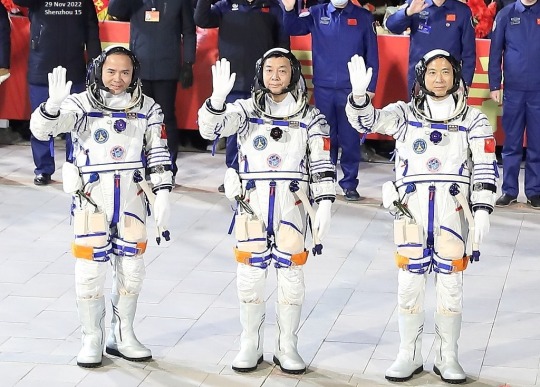
This Tuesday morning, November 29, 2022, the Chinese Shenzhou-15 mission was launched from the Jiuquan Launch Center to the Tiangong space station.
Taikonauts crew at walkout with what looks like Chinese-made “Fiyta” chronographs, strapped over left forearm, no extra wrist watches at first sight.
Shenzhou = "divine boat" launched to Tiangong = "sky palace".
(Photo: China National Space Administration)
6 notes
·
View notes
Text
THE TAIKONAUTS - Surf Music From Outer Space
.
French sci-fi instro surfers from Toulouse. This is their debut slab from 2010. Similar style to early Man or Astro Man stuff but more surfin’. Check it out!
.
.
***in comments!
.

View On WordPress
1 note
·
View note
Text
Siezed by the sudden and overwhelming urge to make a jacket
#i am saving up my money but i mean... i guess I could browse patterns in the meantime#want it to be white with green and orange accents#the orange is important#i dunno why I like that color combo so much but it is what it is#would go so well with my orange Taikonaut boots#ive gotten complimented on those boots they're good boots
0 notes
Text
The International Space Station (ISS) will be retired in 2030 after more than 32 years of continuous service. Naturally, there are questions regarding what will replace this station, which has served as a bastion for vital research and inter-agency cooperation in space. In the past, China has indicated that their Tiangong ("heavenly palace") space station will be a successor and rival to the ISS, offering astronauts from other nations an alternative platform to conduct research in Low Earth Orbit (LEO). As part of this plan, China recently announced plans to double the size of Tiangong in the coming years.
This announcement was shared last Wednesday, October 4th, during the 74th International Astronautical Congress (IAC 2023) in Baku, Azerbaijan. According to the China Academy of Space Technology (CAST), three new modules will be added to Tiangong, which currently consists of the Tianhe Core Cabin Module (CMM) and two Laboratory Cabin Modules (LCM)—Wenhian ("Quest for the Heavens") and Mengtian ("Dreaming of the Heavens"). This expansion will be accompanied by extending the station's operational lifetime.
According to the statement made by CAST, Tiangong will be in service for more than 15 years, 10 more years than previously announced. This means that China intends to keep Tiangong operational until 2037 or later, several years after the ISS is decommissioned and deorbited. As of the penning of this article, the station has been fully operational since late 2022 (a total of 894 days) and has been occupied for the past 764 days. The station has hosted 15 taikonauts (a maximum of three at a time) at orbital altitudes of 340 to 450 km (210 and 280 mi).
Continue Reading.
231 notes
·
View notes
Note
hi, you know a lot of space facts and i thought if anyone knew this it might be you: do you know if anyone has kissed in space before?
This one gets a possibly/likely from me!
The most likely candidates would be Mark Lee and Jan Davis, astronauts who got married in secret before going up on the same space shuttle mission. They didn't tell NASA until right before the flight that they'd gotten married, and NASA was not happy - there was already an unofficial policy against couples on the same flight, which became official after this incident. However, it was too late to train new astronauts, so they got to go.
A quick spin around the web did not turn up any official kiss pics, as that would likely tweak NASA's tail more. It's possible they did, though - although the space shuttle is not huge, and I'm not sure whether they were still keeping it a secret from the rest of the crew. Between discretion, professionalism (astronauts work very hard to get where they are, and they're often scheduled down to the minute! You would not want to hurt your chances of a future mission by annoying your crew and NASA. Plus, women in particular have had a long fight to prove themselves equal to male astronauts and overcome jokes that they've just been shipped up to space as comfort objects, so they wouldn't want to lean into it) and finally that everyone in space is super gross, I doubt any clandestine pecks would go very far. That being said, I am not the best person to ask whether the average human would decide "eh, worth it".
I know less about cosmonatus and taikonauts so IDK if there are any likely candidates there. Also if any couples have gone up on space tourism flights, that's possible. But do tourists even count
50 notes
·
View notes
Text
”tell me something I don’t know”
Astronauts are trained by NASA or the ESA.
Cosmonauts are trained by Roscosmos.
Taikonauts are trained by the CNSA.
Vyomanauts are trained by ISRO
obviously Astronaut is usually just a cover all term but still :]
27 notes
·
View notes
Text

New SpaceTime out Friday....
SpaceTime 20240315 Series 27 Episode 33
Star ripped apart by black hole
Astronomers have uncovered the closest recorded occurrence of a star being torn apart by a supermassive black hole.


Astronomers search for new physics in the debris from colliding neutron stars
Scientists say neutron star mergers are a treasure trove for new physics, with implications for determining the true nature of dark matter.


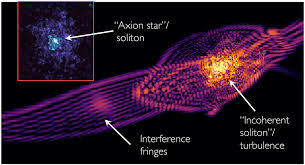


Rocky Earth like planets come with Jupiter like bodyguards
A new study looking at exoplanetary systems has found that terrestrial Earth like planets are often found in systems which also host Jovian like gas giants.
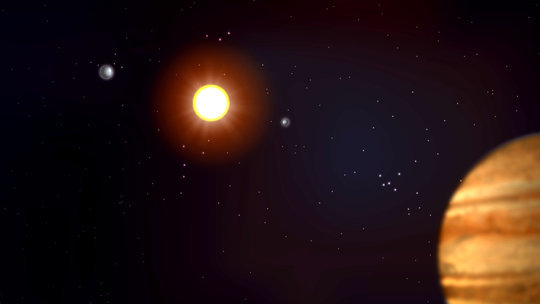
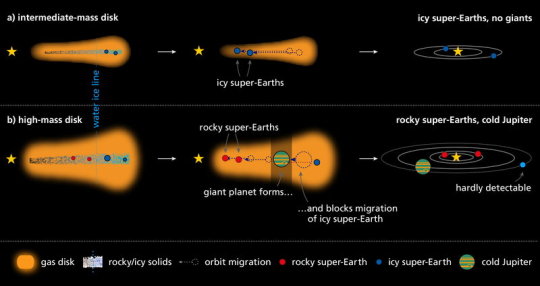
Taikonauts to be on the Moon before the end of the decade
Beijing says it will achieve a manned moon landing before 2030. Central to these efforts is the development of the Long March-10 moon rocket which will be specially designed carry spacecraft and landers into lunar orbit.

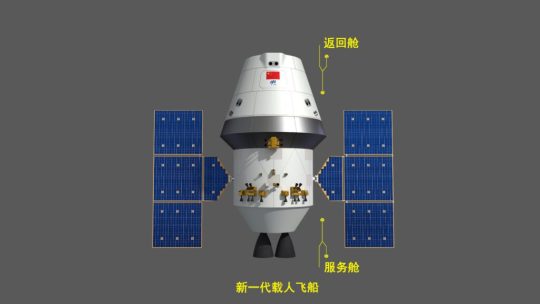
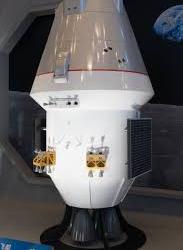

The Science Report
Micro plastics found in plaques of more than half of clogged artery patients.
The link between extreme heat while pregnant and the likelihood of having a preterm birth.
The first half of 2024 likely to see many areas to experience record-breaking air temperatures

Skeptics guide to the world’s most haunted bodies of water
SpaceTime covers the latest news in astronomy & space sciences.
The show is available every Monday, Wednesday and Friday through Apple Podcasts (itunes), Stitcher, Google Podcast, Pocketcasts, SoundCloud, Bitez.com, YouTube, your favourite podcast download provider, and from www.spacetimewithstuartgary.com
SpaceTime is also broadcast through the National Science Foundation on Science Zone Radio and on both i-heart Radio and Tune-In Radio.
SpaceTime daily news blog: http://spacetimewithstuartgary.tumblr.com/
SpaceTime facebook: www.facebook.com/spacetimewithstuartgary
SpaceTime Instagram @spacetimewithstuartgary
SpaceTime twitter feed @stuartgary
SpaceTime YouTube: @SpaceTimewithStuartGary
SpaceTime -- A brief history
SpaceTime is Australia’s most popular and respected astronomy and space science news program – averaging over two million downloads every year. We’re also number five in the United States. The show reports on the latest stories and discoveries making news in astronomy, space flight, and science. SpaceTime features weekly interviews with leading Australian scientists about their research. The show began life in 1995 as ‘StarStuff’ on the Australian Broadcasting Corporation’s (ABC) NewsRadio network. Award winning investigative reporter Stuart Gary created the program during more than fifteen years as NewsRadio’s evening anchor and Science Editor. Gary’s always loved science. He studied astronomy at university and was invited to undertake a PHD in astrophysics, but instead focused on his career in journalism and radio broadcasting. He worked as an announcer and music DJ in commercial radio, before becoming a journalist and eventually joining ABC News and Current Affairs. Later, Gary became part of the team that set up ABC NewsRadio and was one of its first presenters. When asked to put his science background to use, Gary developed StarStuff which he wrote, produced and hosted, consistently achieving 9 per cent of the national Australian radio audience based on the ABC’s Nielsen ratings survey figures for the five major Australian metro markets: Sydney, Melbourne, Brisbane, Adelaide, and Perth. The StarStuff podcast was published on line by ABC Science -- achieving over 1.3 million downloads annually. However, after some 20 years, the show finally wrapped up in December 2015 following ABC funding cuts, and a redirection of available finances to increase sports and horse racing coverage. Rather than continue with the ABC, Gary resigned so that he could keep the show going independently. StarStuff was rebranded as “SpaceTime”, with the first episode being broadcast in February 2016. Over the years, SpaceTime has grown, more than doubling its former ABC audience numbers and expanding to include new segments such as the Science Report -- which provides a wrap of general science news, weekly skeptical science features, special reports looking at the latest computer and technology news, and Skywatch – which provides a monthly guide to the night skies. The show is published three times weekly (every Monday, Wednesday and Friday) and available from the United States National Science Foundation on Science Zone Radio, and through both i-heart Radio and Tune-In Radio.
#science#space#astronomy#physics#news#nasa#esa#astrophysics#spacetimewithstuartgary#starstuff#spacetime#cosmos
16 notes
·
View notes
Text
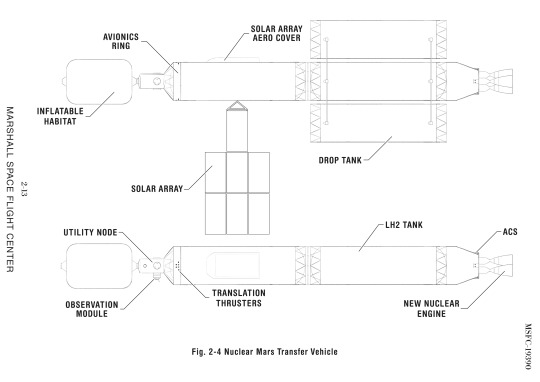
MTV initial study, done by Marshall Space Flight Center, by Max
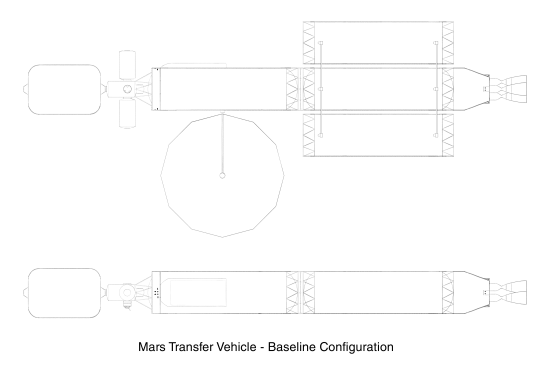
Revised conceptual study for MTV, circa 1982 design freeze, by Max

MTV Minerva being serviced prior to departure on an Olympus mission, as well as OV-106 Intrepid, by Jay
The Olympus Mars Transfer Vehicle was something of a miracle of science and engineering, and showcased some of the greatest cooperation for the entire program as a whole. As important as landing on the surface of Mars is, getting to Mars is a whole different half of the equation, and ensuring that the right equipment would do the job was part of the uphill battle for the program. In the beginning of the design process, it was unclear whether or not the architecture would be chemical, nuclear, or some sort of strange combination of the two. Highly experimental solar electric or even nuclear electric proposals had been thrown around, but it was unclear whether those would be ready in time for the projected late 1990s landing date. Initially, things were dire, as the Olympus Partners stared down the failures of General Atomics to produce a working Valkyrie engine, the key to a reusable nuclear architecture. Ultimately, Lockheed and Naval Reactors would succeed in flying their demonstrator, Way-Seeker, and secure the contract to produce the propulsion section. Boeing would lead the work on Habitat design, a radical new concept for inflatable modules that would enable much greater volume on a single launch. This inflatable habitat would be augmented by a Utility Node, also built by Boeing, and would contain the life support, air lock, and docking systems that would be utilized by ships visiting the MTV. Two Multi Purpose Mission Modules, built by Thales Aerospace, would join the MTV before a mission was due to depart, enabling greater habitable volume and delivering mission specific equipment for the intended landing site. The final component, the Earth Return Lifeboat, would ensure the safety of the crew if something were to go wrong. This capsule would be a large, Apollo CM derived vehicle built by Lockheed and Messerschmitt-Bölkow-Blohm (later Airbus), and could seat a crew of 8.
The MTVs of the Olympus Fleet, Minerva, Prometheus, Hera and Selene, would do their duty well. Each would lead the way in pioneering new triumphs and bring comfort to the crew in times of hardship. They would shelter them from storms, and bring their crews home every time. Even during the disaster of Olympus 9, where all hope seemed lost, Hera gave her all to ensure that her crew would get home safely, sacrificing herself into the inky void of space to throw her passengers home. Towards the end of their usable lives, Minerva, Prometheus and Selene would see continued use supporting Destiny, shuttling cargo landers and crew to and from the lunar surface as infrastructure quickly spread. For the crew of Foundation, the outpost in Noctis, a fleet of new MTVs would emerge, chemical-electric, nuclear and even chemical "cargo sleds" that would push great volumes of equipment. The Americans would lead the charge with their radical Chem-NEP design, the Armstrong class. These would be fully reusable, and leverage design work being done since the start of the program. Japan and Canada would contribute heavily to the Armstrong Class, with logistics modules and robotic arms as their main gifts. Europe's largest contribution would be the Euro-Russian Copernicus Class, a nuclear thermal system based on work done by the Americans in the early days of Olympus. These would be smaller in crew complement but much larger in cargo volume, delivering great aeroshells to the surface. China would also deliver new vehicles, the fully solar-electric Tianzhou class, based on their earlier endeavors in asteroid exploration. These were strictly for cargo, and ensured that Chinese Taikonauts had seats onboard American or European MTVs. This fleet of MTVs would enable a continuous human presence on Mars in the low hundreds throughout the middle of the 21st century.
#proxima: a human exploration of mars#alternate history#science#space#space story#science fiction#alternate future#mars#mars transfer vehicle#NASA#spaceflight#story#worldbuilding
49 notes
·
View notes
Note
I have a legit question, why is it that in english there tends to be specific term for astronaut from X country? Like instead of saying Russian Astronaut, they say Cosmonaut. Instead of saying Chinese Astronaut, they say taikonaut. Why is that?
This isn't exactly unique to English (most Standard Average European* languages make the distinction) but I can still answer.
"Cosmonaut" is simply the anglicization of the Russian космонавт, which is the Russian equivalent of astronaut. Now, why people in the West chose to use the original Russian word instead of saying, like, "Soviet astronaut" probably has something to do with the Cold War and the fact that there may have been some desire to create a more pronounced "us vs them" division between the West and the Soviet Union. The convention has still stuck so astronauts from the former Soviet Union are still called cosmonauts.
"Taikonaut" is not an official term used by the Chinese space program. It seems to have been formed for English language media by analogy with astronaut and cosmonaut, the "taiko" element coming from Chinese tàikōng for "space." To my knowledge it wasn't originally coined in the West but its origins are somewhat unclear, but I feel there's a bit of that aforementioned Cold War mentality and desire to make it clear that these are astronauts working for the Chinese space program in how widespread it has become adopted.
A lot of that is my own conjecture, but as I said this is hardly a uniquely English phenomenon because a lot of languages make those same distinctions.
*SAE is not an actual language family but more like a sprachbund of languages spoken in Western and Central Europe but its borders are hard to define (as a Finnish speaker I consider Finnish to have contracted at least SOME of the features of that sprachbund through language contact and mass media).
9 notes
·
View notes
Text
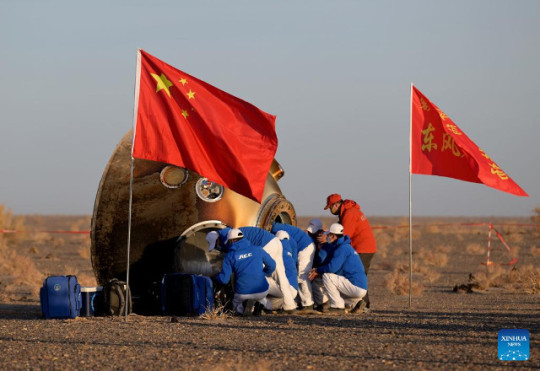
Yesterday, the three Chinese taikonauts of the Shenzhou 16 mission returned to Earth after spending 154 days on the Chinese Tiangong space station, landing at a site called Dongfeng in China's Inner Mongolia Autonomous Region. During the capsule's descent, some observers noticed a hole in the parachute. The speed of descent may have been faster than normal and the capsule toppled over after landing. It has already happened in the past that the capsule didn't remain vertical and no consequences were reported for the taikonauts on board Gui Haichao, Jing Haipeng, and Zhu Yangzhu. In fact, there are no official communications regarding anomalies during the landing.
0 notes
Photo



Digimon art I did as part of Artfight!
Characters belong to @robowilofficial, CrobatOverlord and @taikonaut-variety respectively!
41 notes
·
View notes
Photo
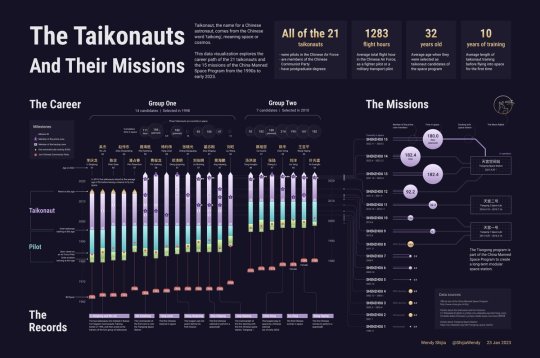
Taikonauts and their missions
Chinese astronauts, and 15 missions in the Manned Space Program.
by @ShijiaWendy
17 notes
·
View notes
Text
INTO THE BIG BLUE! (Instrumental Surfing)
.
Fresh Splash of modern instrumental surfin’ in this Surfadelic comp. featiring bands as THE THUNDERCHIEFS, THE NEBULAS, THE EXOTICS, LES ARONDES, DAIKAIJU, THE RAZORBLADES, THE SURFRAJETTES, THE TAIKONAUTS, THE CHARADES, THE BOMBORAS, THE BEACH BREAKERS, LOS STRAITJACKETS, THE SURFRAJETTES, THE UNTAMED YOUTH, SATAN’S PILGRIMS, THE SURF COASTERS, SLACKTONE, THE SADIES, JOHN REIS & THE BLIND…

View On WordPress
7 notes
·
View notes
Text
China continues to take great strides as part of its goal to become a superpower in space and a direct competitor with NASA.
In addition to its proposed expansion of the Tiangong space station and the creation of the International Lunar Research Station (ILRS), China is also planning on sending crewed missions to Mars in the coming decade.
In preparation for the arrival of taikonauts on the Red Planet, China is gearing up to return samples of Martian soil and rock to Earth roughly two years ahead of the proposed NASA-ESA Mars Sample Return (MSR).
This mission will be the third in the China National Space Administration's (CNSA) Tianwen program (Tianwen-3) and will consist of a pair of launches in 2028 that will return samples to Earth in July 2031.
Continue Reading.
128 notes
·
View notes
Text
2 notes
·
View notes